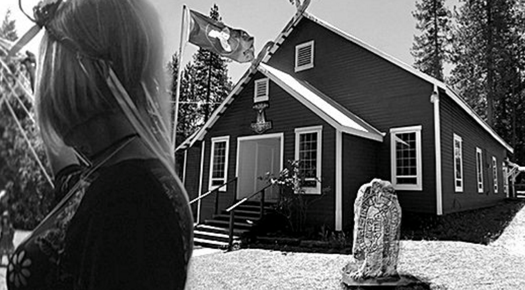
Nothing about the setting of undulating foothills, redwoods and pines in Sierra Nevada resonate the Vikings, Scandinavia or the Norse gods. Yet, at the corner of one meandering two-lane road, stands an old barnlike structure that has been decorated to resemble a longhouse with dragon-headed door hinges and Thor’s mjolnir above its front door.

This new structure is meant to serve as the first freestanding, public Heathenry hof in the United States, where members of Asatru Folk Assembly, an organization that claims to have at least 700 congregants, will meet to revive the ancient religion of the Norse gods through prayer and worship.
“We knew this was where we were supposed to be,” said Stephen McNallen, AFA’s 66-year-old founder, as he led a tour through the hof and its “ve,” an outdoor circle of trees and stones where various rituals will be held. “We made an offering to the gods and let it be known that we wanted to be here. And 90 days later it was ours.”
With approximately 80 people in attendance, the hof or hall was inaugurated last month with a blot or ritual comprising of candles, fires, banners, prayers, blessings and sacred mead. While some members traveled from as far away as Florida, where AFA seems to have a strong presence, some others visited from Pennsylvania, where there is another sizable assembly of Asatruars. Of course, there are smaller groups of individuals who practice Asatru in several other states across America. Even though there is no exact count of the total number of Asatruars in the United States, a heathen census that was conducted by Karl E H Seigfried of The Norse Mythology Blog put the number at a little less than 8,000 in 2013.
Asatruars worship a variety of Norse gods including Thor, Odin, Frigg, and Freyr, though the invocation of ancestors plays an equally important part in this folk religion. Revived from the pre-Christian era during the 1970s, Asatru started to flourish once again in Scandinavia before spreading to the United States. In February this year, Asatruars in Iceland announced that they had broken ground on a new, circular hof though it has not yet been completed. And even though other hofs –including rooms inside houses, backyard sheds, rented sites and makeshift structures– have been sparsely spotted across America, this one located in the rural area of Brownsville (approximately 75 miles north of Sacramento) is reportedly the largest of its kind in North America.
This 4,100-square-foot building, which was constructed in 1938, has already served as a school, church and agricultural hall in the past until AFA managed to raise over $54,000 on Indiegogo.com to purchase the property. The inauguration of this hof is a sign of maturity for not only AFA, whose roots date back to the 1970s, but also scholars and advocates of American Heathenry, which constitutes several ancient polytheistic religions that have witnessed contemporary revivals.
“This is a validation of 45 years of work,” said McNallen, sitting under some cedar trees shaded by a large boulder that will serve as an outdoor altar. “I feel I am entering a new phase in my relationship with the holy powers as a result of this hof.”
A week before the inaugural ritual that focused on the invocation of Asatruars’ female ancestors, the Brownsville hof was busy with volunteers who helped to clean, paint, decorate and carve.
Bradley Taylor Hicks, AFA’s chief of staff and a member of its clergy, said, “In America, we (followers of Norse religions) don’t have sacred spaces. And we had to establish a practice. This is a place where we can help people do that.”
Jessica Roesner, who is a welder, helped blowtorch some Viking-inspired metalwork. Even though she was brought up as a Christian, Roesner started to learn about Asatru after discovering AFA about two years ago.
“I felt a call,” she said. “The stories about the gods made sense.”
Thorgrun Thomson Odden and his wife Katie, who helped with the construction of the hof’s new front doors, revealed that they turned to Asatru in 1992.
“This is a centering for us,” he said. “It is like a home. There is a power here in the forest. You can feel it. This is ours. We don’t have to leave it. We can build on it.”
Photo Credits: Asatru Folk Assembly
